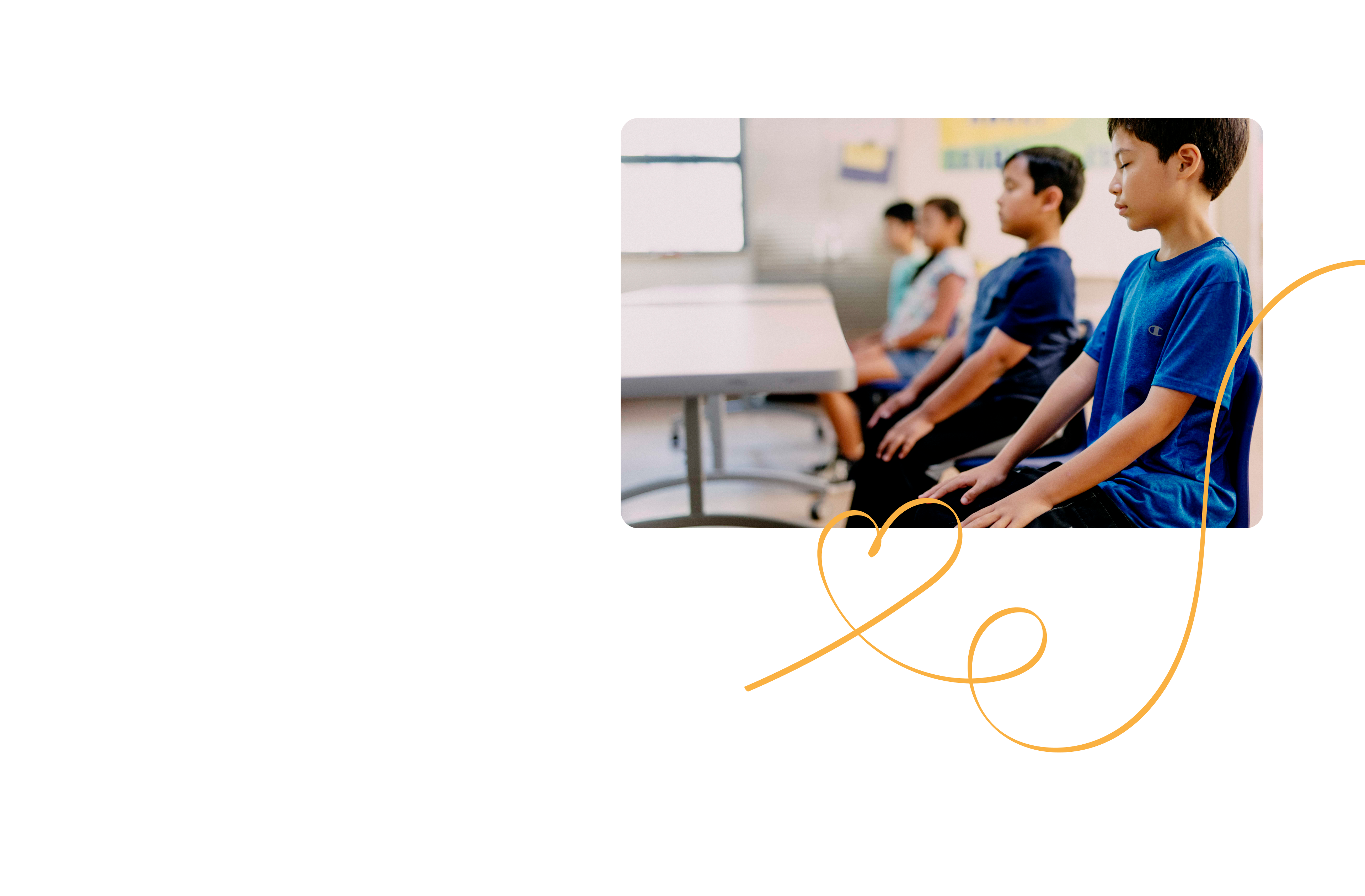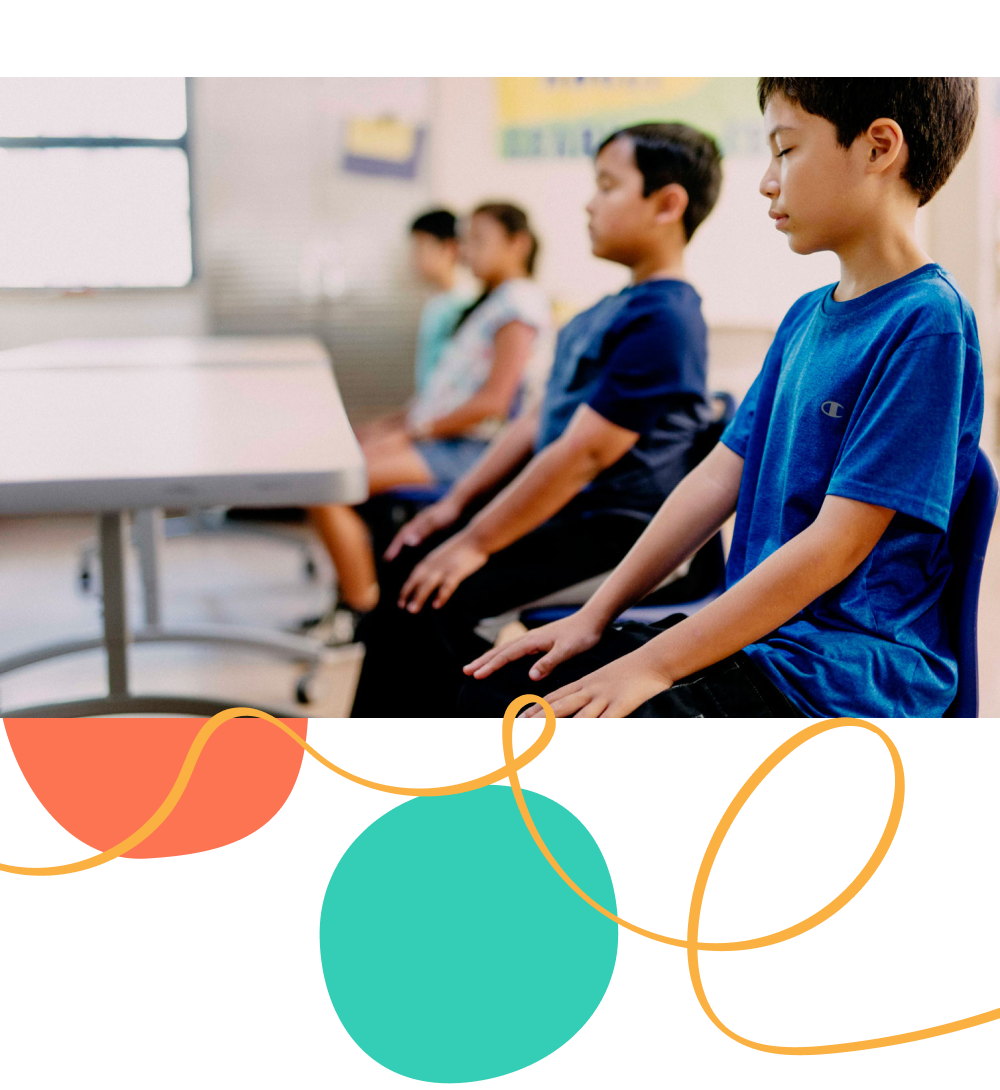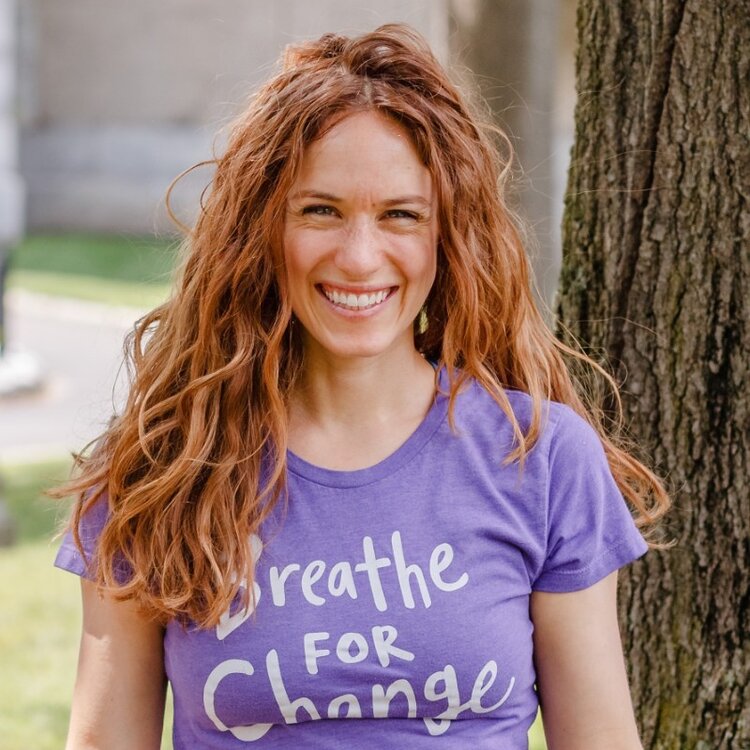Being an educator involves pouring many invisible hours into your work: the planning and preparation is a big part you just can’t skip. Creating lesson plans and choosing curriculum content can be hard work. However, think about the last time your students’ eyes lit up because they finally understood a concept. If you’ve witnessed this, you’ll know it’s extremely rewarding when you see positive effects reflected in your students.
Planning and preparation give your teaching approach structure. However, what isn’t quite so predictable is how your students are going to act or respond to the learning environment on any given day. Sometimes, your meticulously organized lesson plan can go awry as students chatter, misbehave, or lack focus.
It can be extremely frustrating when you don’t feel in control of your classroom, but you’re not alone. Most teachers (85%) feel ‘less than very well prepared’ to manage their classrooms or discipline students. Less than a third (26%) receive help to improve their classroom management skills.
You can only plan so much for unpredictable, disruptive behavior. However, having solid classroom management strategies in your locker will set you up for success.
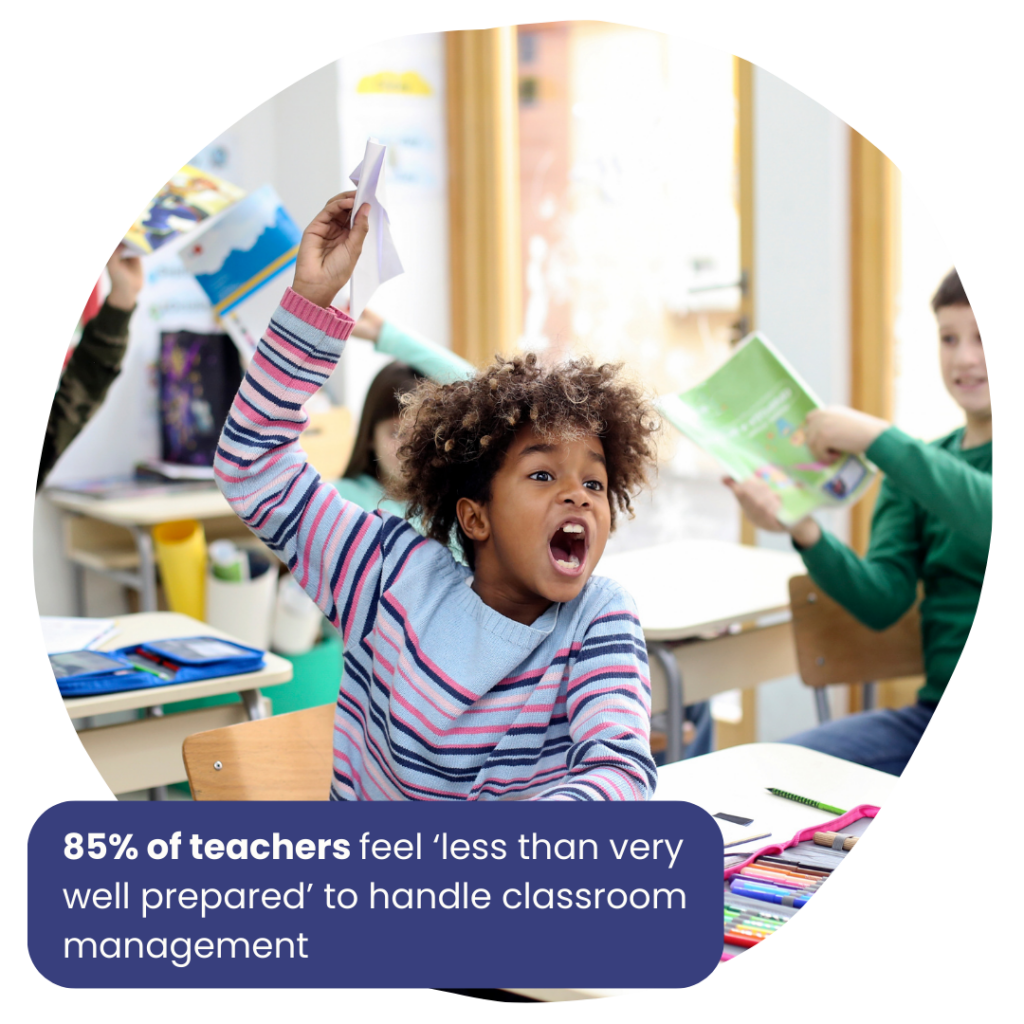
In this article, we share our advice on teacher classroom management by taking you through some effective classroom management strategies to help you:
- Establish and maintain control of the classroom
- Encourage positive behavior in your students
- Enrich student focus and learning
- Improve your own classroom experience as an educator
We also share how mindfulness, social-emotional learning (SEL), and yoga in classrooms can help create a calmer and happier environment, leading to improved mental wellness, learning, building relationships, and effective teaching.
What Are Classroom Management Strategies and Why Are They Important?
Classroom management strategies are techniques teachers can use to help create a positive, productive learning environment and a controlled classroom. They include different methods for keeping students engaged, respectful, and focused in the learning environment.
These strategies do more than keep students quiet and seated. They help with relationship-building, setting clear expectations, and creating a space where everyone feels valued and able to learn.
The most effective classroom management isn’t just about classroom rules and control – it’s also about creating a collaborative, supportive classroom culture. This is where learning and well-being can truly flourish. This applies to elementary school, middle school, high school, further education – and everything in between.
Successful classroom management supports:
- Setting and managing expectations
- Reducing disruption
- Improving concentration and engagement
- Managing student behavior and handling disruptive students
- Better teacher-student dynamics
- Improving academic performance, productivity, engagement, and overall grades
- Improving student attendance rates
- Cultivating a safe space where everybody can experience meaningful learning within large group work, small groups, and individual work
- Prioritizing mental wellness (lower stress levels, anxiety, frustration, etc.)
- Establishing structure and consistency
- Developing social skills and soft interpersonal skills
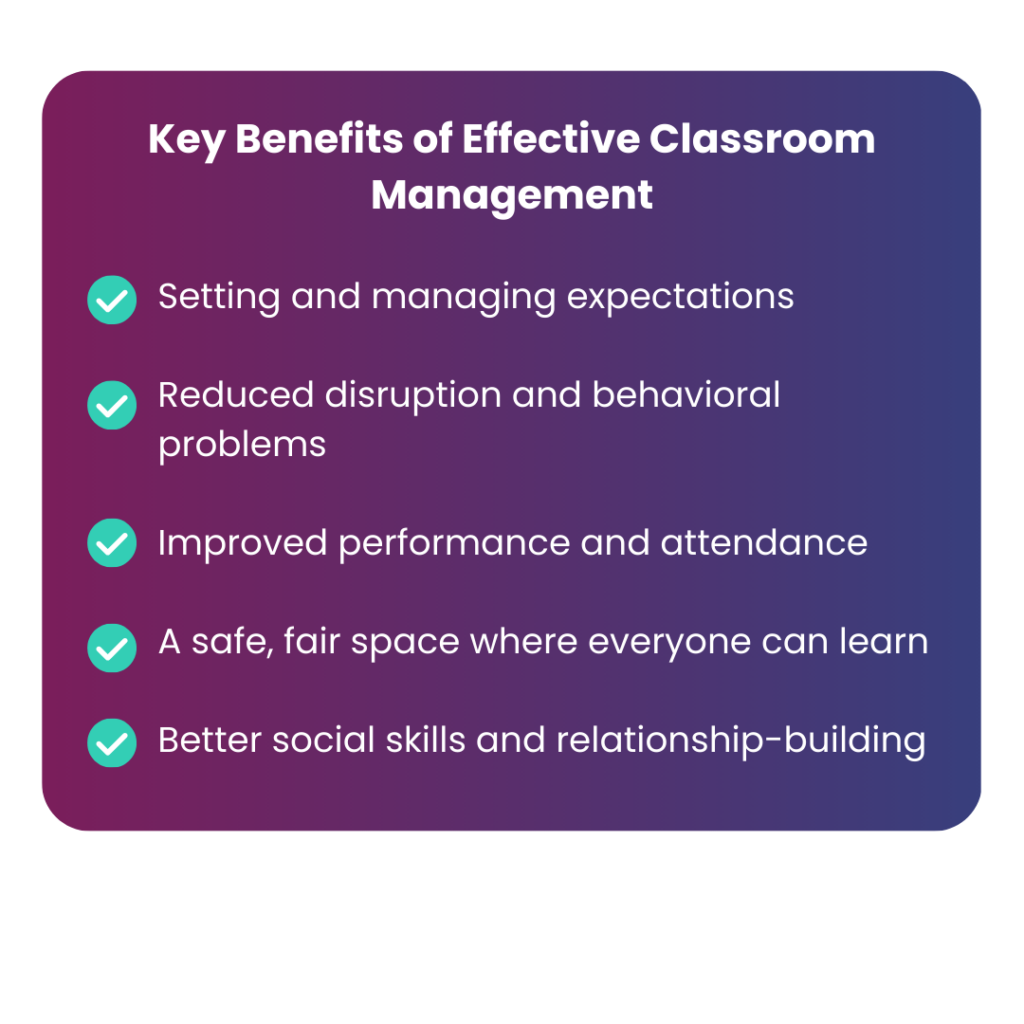
4 Strategies for Effective Classroom Management
Mastering the fundamentals of classroom management can help educators feel more prepared and in control of their classrooms.
By definition, classroom management strategies are the most effective when you approach it by having a plan yet simultaneously being open to adapting the plan when student behavior is different than expected. Being flexible with your framework of techniques will help you avoid feeling overwhelmed in the classroom because you’ll feel ready for anything that pops up.
1. Display model behavior
The best way to communicate with students how you want them to behave is to role model it — follow the ‘monkey see, monkey do’ method. For example, if you’re feeling stressed out and frustrated, think about how you would want your students to deal with the same emotions and act accordingly.
Other good rules to live and teach by:
- Use respectful, polite language
- Stay calm and collected
- Don’t speak over people
- Never resort to physical or verbal aggression
2. Clear expectations
Hold students accountable to expectations by fairly correcting undesirable behavior and actions. Then, make sure to do this consistently so that your message is strong, clear, and not confusing.
Be transparent with your students about the behavior you expect to see from them and be open about the consequences if these expectations aren’t met. Doing this as a group at the start of the semester is very helpful.
An exercise that we love to do is called the Umbrella of Respect. To practice this, draw an umbrella, and as a group, brainstorm what it means to feel respected: What behaviors are associated with respect? You can hang this drawing up on the wall and refer back to it, so the group feels involved in the process.
Treat all students equally in terms of consequences and hold them to the same standards, unless there is a reason to allow leniency. This could apply to a student with additional learning needs or a student with a disruptive behavior diagnosis such as attention deficit hyperactivity disorder (ADHD).
3. Physical proximity and classroom layout
The conventional classroom configuration is to have the teacher standing at the front and students seated in rows in front of them. However, this doesn’t always allow for an equal amount of physical proximity or attention.
Being more flexible with your classroom layout and considering different configurations will help you:
- Have better visibility of all your students so you can easily monitor what they’re doing
- Divide your time more equally between your students so you can get to know all of their emotional states and learning styles more comprehensively.
- Navigate the room easily
Plus, the traditional setup won’t be suitable for all tasks or student needs. Providing an inclusive and comfortable environment will contribute towards a calmer, more controlled classroom.
4. Positive reinforcement
In a US study of children aged 5-12 by Brigham Young University, spearheaded by Dr. Paul Caldarella, ‘statements of praise’ increased focus by up to 30%. This proves the power of positive reinforcement in influencing classroom conduct.
In order to see more of your desired behavior, make sure you’re quick and generous when it comes to praising when students do something good or well. Praise is a positive experience that other students will witness and want to emulate for themselves.
Although this is true, when praising your students make sure that you’re giving them effective praise that focuses on their work rather than more generalized praise like, “I am so proud of you.” Praise can also be well-received and transformative for students when it’s behavior-specific. It can be anything like, “Thanks for waiting patiently for your turn!” or “Great job listening to the speaker at today’s assembly, everyone.”
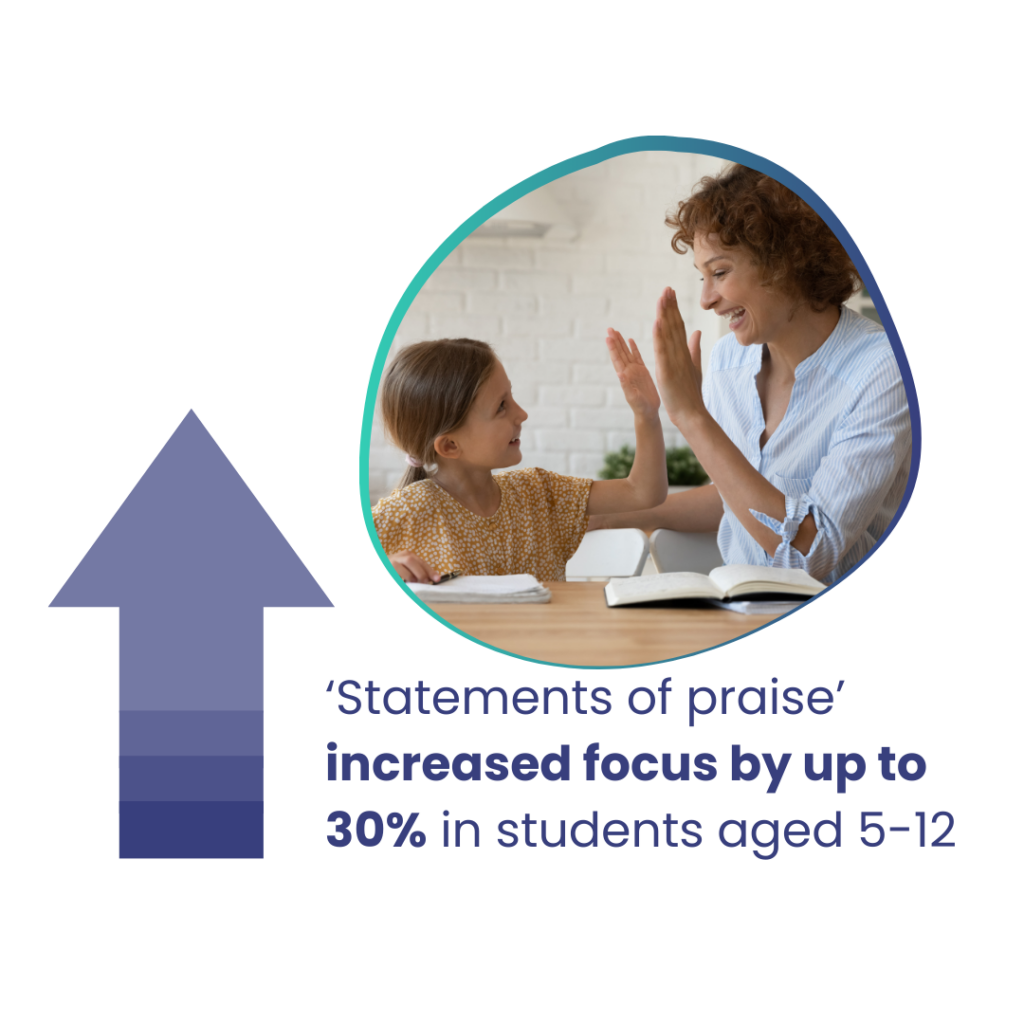
Supporting classroom control guidance
Below are some other tactics you can use to support your classroom management strategies and ensure you’re reaping the rewards of your efforts:
- Exercise patience and show compassion
- Use eye contact, a calm voice, and non-verbal communication (i.e., intentional body language)
- Involve students in the process – be transparent about the goals of your class management strategies
- Document rules and guidelines – make them visible and accessible to everybody
- Don’t punish the whole class due to individual or group behaviors
- Address undesirable behavior quickly – be firm but fair
- Celebrate achievements and positive performance
Mindfulness, SEL, and Yoga
Having a framework of classroom control techniques in place to help you mitigate and manage disruptive behavior is essential. However, it also helps to dig a little deeper and build a healthy foundation for mental wellness.
Of course, this could take many forms and will vary from student to student, depending on their personal circumstances. However, mindfulness, social-emotional learning (SEL), and yoga are effective ways to nurture better mental and physical well-being in general, including the expression of emotions, cognitive function, and behavioral reactions.
When analyzing the impact of introducing yoga into the high school curriculum, a study found that it resulted in improved relationship-building and better self-regulation of emotions. Plus, students are 42% less likely to say they were involved in physical aggression when involved with SEL, and 24% demonstrated improved social behaviors following an SEL program.
Dr. Christina Cipriano, an expert in the science of learning and development, also explains how: “When students are struggling, and school performance is poor, they are more likely to find school and learning as a source of anxiety, manifesting in diminished self-efficacy, motivation, engagement, and connectedness with the school”. This can lead to disruptive classroom behavior or poor focus.
In situations like this, SEL, mindfulness, and yoga can really transform a student’s school experience. SEL helps students recognize and regulate their emotions, build resilience, and build positive relationships – all of which are key for making them feel like they have a sense of belonging and purpose at school. Mindfulness and yoga help students grow even further by calming down their nervous systems, and sharpening their focus. Together, all of these practices are the foundation of improved emotional regulation.
Training for Teachers at Breathe for Change
Our Mindfulness, Social-Emotional Learning (SEL), and Yoga Teacher Training program is designed to empower educators in transforming the physical and mental well-being of themselves, other educators, and students. Our program takes a unique approach by integrating mindfulness and yoga for a holistic approach to SEL and classroom management.
Applying the knowledge and techniques you will learn in the program will help you cultivate calmer, more productive learning environments. Apply today to get started.
